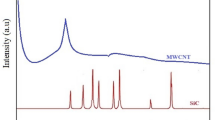Abstract
Pb(Zr, Ti)O3(PZT)-based piezoelectric ceramics and Al2O3-based structural ceramics were cast and co-fired to prepare a layered piezoelectric ceramic/structural ceramic composite. Considering the significant differences in sintering characteristics of PZT- and Al2O3-based ceramics, control of the sintering temperature and the dependence of the linear shrinkage on the solid content of the tape-casting films were systematically conducted at first. The sintering density and the interface bonding properties of the prepared composites were then investigated. The results of electrical and mechanical properties of the composite ceramics indicate: By using sintering aids, Al2O3 ceramic could be fully densified and co-fired with PZT ceramic at 1150 °C. Shrinkage matching during sintering was achieved by adjusting the solid contents to 45 vol.% and 65 vol.% for PZT and alumina tape-casting films. In the layered composites, Al2O3 structural ceramic presents an excellent mechanical property with HV hardness of 667, while the PZT functional ceramic presents d33, εr and tanδ of 259 pC/N, 965 and 0.37%, respectively.






Similar content being viewed by others
References
Ryu JH, Carazo AV, Uchino K, Kim HE (2001) Magnetoelectric properties in piezoelectric and magnetostrictive laminate composites. Jpn J Appl Phys 40:4948–4951. https://doi.org/10.1143/JJAP.40.4948
Sglavo VM, Bertoldi M (2006) Design and production of ceramic laminates with high mechanical resistance and reliability. Acta Mater 54(18):4929–4937. https://doi.org/10.1016/j.actamat.2006.06.019
Peng R, Li Y, Lu Y, Yun Y, Du W, Tao Z, Liao B (2020) High-performance microwave dielectric composite ceramics sintered at low temperature without sintering-aids. J Alloy Compd 831:154878. https://doi.org/10.1016/j.jallcom.2020.154878
Chawla KK (2013) Ceramic matrix composites. Springer Science & Business Media, New York
Coelho PG, Guedes JM, Rodrigues HC (2015) Multiscale topology optimization of bi-material laminated composite structures. Compos Struct 132:495–505. https://doi.org/10.1016/j.compstruct.2015.05.059
Kiyono CY, Silva ECN, Reddy JN (2016) Optimal design of laminated piezocomposite energy harvesting devices considering stress constraints. Int J Numer Meth Eng 105(12):883–914. https://doi.org/10.1002/nme.4996
Sinchuuk Y, Piat R, Roy S, Gibmeier J, Wanner A (2011) Inelastic behavior of the single domain of metal-ceramic composites with lamellar microstructure. Pamm 11(1):285–286. https://doi.org/10.1002/pamm.201110134
Zhao CP, Fang F, Yang W (2010) A dual-peak phenomenon of magnetoelectric coupling in laminated Terfenol-D/PZT/Terfenol-D composites. Smart Mater Struct 19(12):125004. https://doi.org/10.1088/0964-1726/19/12/125004
Akedo J (2008) Room temperature impact consolidation (RTIC) of fine ceramic powder by aerosol deposition method and applications to microdevices. J Therm Spray Technol 17(2):181–198. https://doi.org/10.1007/s11666-008-9163-7
Baba S, Akedo J (2009) Fiber laser annealing of nanocrystalline PZT thick film prepared by aerosol deposition. Appl Surf Sci 255(24):9791–9795. https://doi.org/10.1111/j.1551-2916.2006.01030.x
Akedo J (2006) Aerosol deposition of ceramic thick films at room temperature: densification mechanism of ceramic layers. J Am Ceram Soc 89(6):1834–1839. https://doi.org/10.1111/j.1551-2916.2006.01030.x
Fernie JA, Roberts MD, Wang Y, Kavilveedu NR, Brown D (2015) Double transition joint for the joining of ceramics to metals. US patent. US9011620
Hu F, Liu W, Xie Z (2016) Surface modification of alumina powder particles through stearic acid for the fabrication of translucent alumina ceramics by injection molding. Ceram Int 42(14):16274–16280. https://doi.org/10.1016/j.ceramint.2016.07.164
Jian G, Hu Q, Lu S, Zhou D, Fu Q (2012) Effect of solid content variations on PZT slip for tape casting. Process Appl Ceram 6(4):215–221. https://doi.org/10.2298/PAC1204215J
Cristofolinia I, Raob A, Menapace C, Molinarib A (2010) Influence of sintering temperature on the shrinkage and geometrical characteristics of steel parts produced by powder metallurgy. J Mater Process Tech 210(13):1716–1725. https://doi.org/10.1016/j.jmatprotec.2010.06.002
Qin Y, Zhong CW, Yang HY et al (2019) Enhanced thermal and mechanical properties of Li–Al–Si composites with K2O–B2O3–SiO2 glass for LTCC application. Ceram Int 45:15654–15659. https://doi.org/10.1016/j.ceramint.2019.05.077
Zhou XH, Ning XQ, Zhang X et al (2020) Influence of Li2O–MgO–ZnO–B2O3–SiO2 glass doping on the microwave dielectric properties and sintering temperature of Li3Mg2NbO6 ceramics. J Mater Sci Mater Electron 31:17029–17035. https://doi.org/10.1007/s10854-020-04260-3
Bhuyan RK, Kumar TS, Pamu D (2017) Liquid phase effect of Bi2O3 additive on densification, microstructure and microwave dielectric properties of Mg2TiO4 ceramics. Ferroelectrics 516(1):173–184. https://doi.org/10.1080/00150193.2017.1362226
Zuo R, Li L, Gui Z (2001) Relationships between interfacial interaction, electrode formulation and cofiring mismatch of relaxor-based multilayer ceramic devices. J Mater Sci Mater Electron 12(2):117–121. https://doi.org/10.1023/A:1011258321843
Lin JC, Chan JY (1996) On the resistance of silver migration in Ag-Pd conductive thick films under humid environment and applied dc field. Mater Chem Phys 43(3):256–265. https://doi.org/10.1016/0254-0584(95)01642-8
Yoo JH, Kim SW, Lee ES, Choi NG, Jeong HS (2019) Microstructure and piezoelectric properties of PMN-PNN-PZT ceramics with the variation of PMN. Trans Electron Electron Mater 20(1):31–35. https://doi.org/10.1007/s42341-018-00088-1
Zhang Y, Zhu X, Zhu J, Zeng X, Feng X, Liao J (2016) Composition design, phase transitions and electrical properties of Sr2+-substituted xPZN–0.1 PNN–(0.9–x) PZT piezoelectric ceramics. Ceram Int 42(3):4080–4089. https://doi.org/10.1016/j.ceramint.2015.11.080
Omran KH, Abd El-sadek MS, Mostafa M, Hemeda OM (2020) Influence of PbO phase content on structural and optical properties of PZT nanopowders. Appl Nanosci 10(7):2315–2327. https://doi.org/10.1007/s13204-020-01390-2
Mao Y, Banerjee S, Wong SS (2003) Hydrothermal synthesis of perovskite nanotubes. Chem Commun 3(3):408–409. https://doi.org/10.1039/B210633G
Jiang XS, Wang NJ, Zhu DG (2014) Friction and wear properties of in-situ synthesized Al2O3 reinforced aluminum composites. Trans Nonferr Metals Soc China 24(7):2352–2358. https://doi.org/10.1016/S1003-6326(14)63356-2
Acknowledgements
This work was financially supported by Introduction of Talent Research Start-up Fund of Nanjing Institute of Technology (No. YKJ201960), the 111 project (No. B12021) and the Priority Academic Program Development of Jiangsu Higher Education Institutions.
Author information
Authors and Affiliations
Corresponding authors
Additional information
Handling Editor: David Cann.
Publisher's Note
Springer Nature remains neutral with regard to jurisdictional claims in published maps and institutional affiliations.
Rights and permissions
About this article
Cite this article
Bian, K., Li, X., Wang, Y. et al. Co-firing preparation and properties of piezoelectric ceramic/structural ceramics layered composites. J Mater Sci 56, 13023–13030 (2021). https://doi.org/10.1007/s10853-021-06160-1
Received:
Accepted:
Published:
Issue Date:
DOI: https://doi.org/10.1007/s10853-021-06160-1




